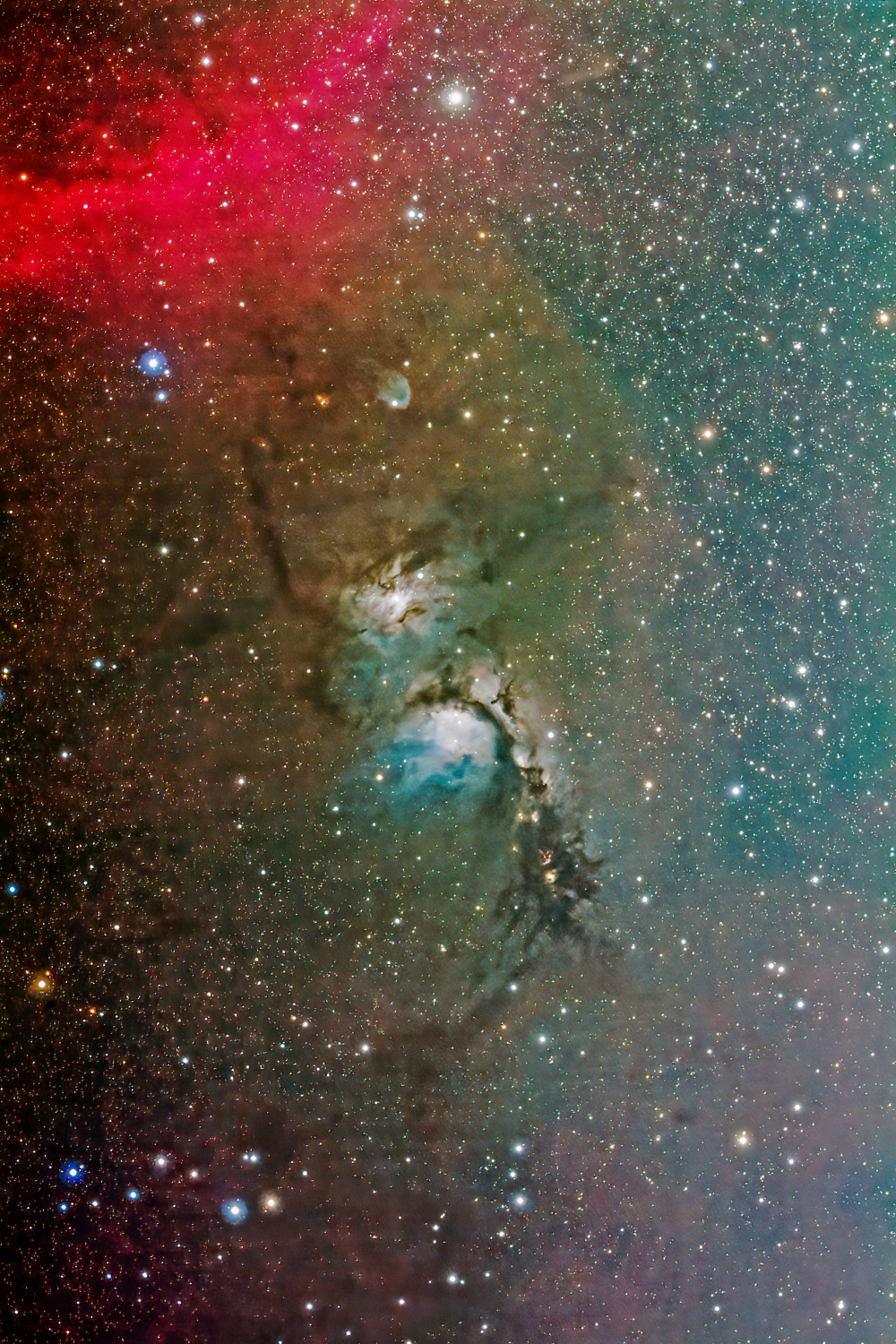Messer 78 with Nebula Complex





History
This nebula was first sighted by Pierre Méchain in March 1780 and added by Charles Messier as object number 78 in his catalog of comet-like celestial objects on December 17 of the same year. He made a note of it. «A cluster of stars with a lot of nebula». The slightly weaker part NGC 2071 further north escaped him at that time. It was only discovered by William Herschel on 1 January 1786. Admiral Smyth saw «two stars in a very thin nebula» and Lord Rosse believed he saw a spiral structure in them. At that time it was still believed that spiral nebulae (galaxies) were located within our galaxy. [4, 196]
Physical Properties

As you can see on the infrared image in Fig. 3, M 78 is the brightest part of a nebula crossed by dark clouds, the brightest areas of which have been assigned the NGC numbers 2064, 2067, 2068 and 2071. These are mainly reflection nebulae, i. e. clouds of dust that reflect the light from stars and hardly shine themselves. With M 78 it is the two B-type stars (HD 38563 A and B) which illuminate the dust. Due to gravity, the cloud has accumulated in several «clumps». New stars are forming inside. The whole cloud belongs to the Orion Molecular Cloud Complex and is around 1,350 light years away. [196]
Further deep sky objects that belong to the Orion Molecular Cloud Complex:
- Messier 42 (Orion Nebula)
- Messier 43 (NGC 1982, northern part of Messier 42)
- NGC 1980 (open star cluster, south of Messier 42)
- NGC 1981 (open star cluster, north of Messier 42)
- Horsehead Nebula (Barnard 33 in front of IC 434)
- NGC 2023: Lump Star (reflection nebula around 7.82 mag star HD 37903)
- NGC 2024: Flaming Tree Nebula
- IC 435 (reflection nebula around 8.3 mag star HD 38087)
- Barnard Loop (Sharpless 2-276)
- Witch Head Nebula (IC 2118)
- uvm.
| Name | RA | Dec | Type | bMag | Dim | MD | Dreyer Description | Identification, Remarks |
|---|---|---|---|---|---|---|---|---|
| NGC 2064 | 05 46 18.4 | +00 00 21 | RN | 1 × 1 | 0.500 | eF, vS, * 9·10 np 4' | GC 5355; LBN 1627; part of M 78 | |
| NGC 2067 | 05 46 32.0 | +00 07 54 | RN | 8 × 3 | 0.500 | F, pL, M 78 s | GC 5356; DG 79; part of M 78 | |
| NGC 2068 | 05 46 45.0 | +00 04 48 | RN | 8.0 | 8 × 6 | 0.500 | B, L, wisp, gmbN, 3 st inv, r | h 368; GC 1267; M 78; DG 80 |
| NGC 2071 | 05 47 07.2 | +00 17 39 | RN | 8.0 | 7 × 5 | 0.500 | D * (10 & 14 m) with vF, L chev | WH IV 36; GC 1270; LBN 938 |
Finder Chart
The reflection nebula M78 is positioned exactly on the celestial equator. It lies slightly above the left belt star Alnitak (ζ Orionis) of the constellation Orion. The reflection nebula is stated to be the brightest of its kind. Indeed, it is relatively easy to find and is quite noticeable with its brightness. [192] The constellation is best observed in the months of August to May.
Visual Observation
320 mm Aperture: The galactic nebula NGC 2071 is located on the star closer to M 78 by a pair of stars of the same brightness. With averted vision you can see a wide and fine nebula. — 12.5" f/4.5 Ninja-Dobsonian, Glaubenberg 1400 m. ASL., 02. 03. 2025, Elena + Eduard von Bergen
350 mm Aperture: The shape is slightly U-shaped and resembles a comet's head. Two bright stars lying in the nebula disturb the picture or dazzle the viewer in detail. However, one perceives a few dark, black areas. The OIII filter was of no help with this item. Without a filter, the reflection nebula M78 was easier and better to view. >14" PWO-Dobson, F:4.6 / TV-Nagler 13mm, 123x, 0.67° und TV-Radian 8mm, 200x, 0.3°, 2004 Eduard von Bergen [192]
